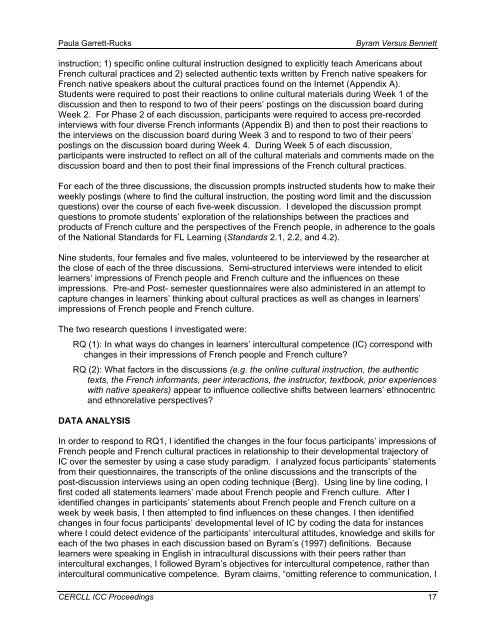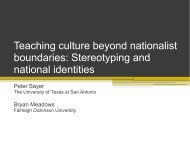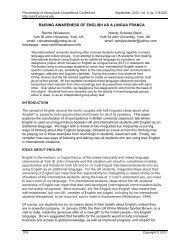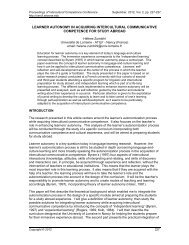BYRAM VERSUS BENNETT: DISCREPANCIES IN THE ... - CERCLL
BYRAM VERSUS BENNETT: DISCREPANCIES IN THE ... - CERCLL
BYRAM VERSUS BENNETT: DISCREPANCIES IN THE ... - CERCLL
You also want an ePaper? Increase the reach of your titles
YUMPU automatically turns print PDFs into web optimized ePapers that Google loves.
Paula Garrett-Rucks Byram Versus Bennett<br />
instruction; 1) specific online cultural instruction designed to explicitly teach Americans about<br />
French cultural practices and 2) selected authentic texts written by French native speakers for<br />
French native speakers about the cultural practices found on the Internet (Appendix A).<br />
Students were required to post their reactions to online cultural materials during Week 1 of the<br />
discussion and then to respond to two of their peers’ postings on the discussion board during<br />
Week 2. For Phase 2 of each discussion, participants were required to access pre-recorded<br />
interviews with four diverse French informants (Appendix B) and then to post their reactions to<br />
the interviews on the discussion board during Week 3 and to respond to two of their peers’<br />
postings on the discussion board during Week 4. During Week 5 of each discussion,<br />
participants were instructed to reflect on all of the cultural materials and comments made on the<br />
discussion board and then to post their final impressions of the French cultural practices.<br />
For each of the three discussions, the discussion prompts instructed students how to make their<br />
weekly postings (where to find the cultural instruction, the posting word limit and the discussion<br />
questions) over the course of each five-week discussion. I developed the discussion prompt<br />
questions to promote students’ exploration of the relationships between the practices and<br />
products of French culture and the perspectives of the French people, in adherence to the goals<br />
of the National Standards for FL Learning (Standards 2.1, 2.2, and 4.2).<br />
Nine students, four females and five males, volunteered to be interviewed by the researcher at<br />
the close of each of the three discussions. Semi-structured interviews were intended to elicit<br />
learners’ impressions of French people and French culture and the influences on these<br />
impressions. Pre-and Post- semester questionnaires were also administered in an attempt to<br />
capture changes in learners’ thinking about cultural practices as well as changes in learners’<br />
impressions of French people and French culture.<br />
The two research questions I investigated were:<br />
RQ (1): In what ways do changes in learners’ intercultural competence (IC) correspond with<br />
changes in their impressions of French people and French culture?<br />
RQ (2): What factors in the discussions (e.g. the online cultural instruction, the authentic<br />
texts, the French informants, peer interactions, the instructor, textbook, prior experiences<br />
with native speakers) appear to influence collective shifts between learners’ ethnocentric<br />
and ethnorelative perspectives?<br />
DATA ANALYSIS<br />
In order to respond to RQ1, I identified the changes in the four focus participants’ impressions of<br />
French people and French cultural practices in relationship to their developmental trajectory of<br />
IC over the semester by using a case study paradigm. I analyzed focus participants’ statements<br />
from their questionnaires, the transcripts of the online discussions and the transcripts of the<br />
post-discussion interviews using an open coding technique (Berg). Using line by line coding, I<br />
first coded all statements learners’ made about French people and French culture. After I<br />
identified changes in participants’ statements about French people and French culture on a<br />
week by week basis, I then attempted to find influences on these changes. I then identified<br />
changes in four focus participants’ developmental level of IC by coding the data for instances<br />
where I could detect evidence of the participants’ intercultural attitudes, knowledge and skills for<br />
each of the two phases in each discussion based on Byram’s (1997) definitions. Because<br />
learners were speaking in English in intracultural discussions with their peers rather than<br />
intercultural exchanges, I followed Byram’s objectives for intercultural competence, rather than<br />
intercultural communicative competence. Byram claims, “omitting reference to communication, I<br />
<strong>CERCLL</strong> ICC Proceedings 17





